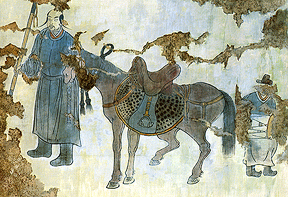
featuring a Khitan horseman and his steed
Mid-Liao dynasty, c. 11th c
From Tomb #1 at Beisanjia Village Site
Aohan Banner, Chifeng Municipal District
Image courtesy of the Inner Mongolian Museum, Huhehaote (copyright reserved)
This painting was found on the wall of a tomb located near the site of Shangjing, literally "Upper Capital," the central administrative city of the Liao dynasty. This tomb, known as Tomb #1, was discovered after it was partially exposed in the aftermath of an intense rain storm. It was created for the burial of a Khitan man and his wife (possibly the high official Xiao Quli, who married Zhigu, the daughter of the dynasty's founder Yelu Abaoji). Inscriptions dating the tomb to 959 make it the oldest of the Liao-era tombs excavated in Inner Mongolia.1
The tomb painting features a Khitan warrior leading his mount, and accompanied by a man of smaller stature, who appears to be beating a drum. The painting subject is dressed in a manner quite distinctive from contemporaneous Song aristocrats in his high boots and long tunic, along with his shaved pate and short plaits of hair descending from his temples. The image of both this man and his horse are well preserved. This fact, along with large amount of horse harnesses and fittings found among the over 2000 objects excavated from this site, give us a clear picture of the importance of horse-riding culture among the Khitan, as well as specific manner of equipment they utilized. The extremely high quality of the craftsmanship that went into making the fittings preserved in the tomb, along with the nature of the designs, indicate that most of the work was completed by Chinese craftsmen.
(1) This and all other information on Tomb #1 at Beisanjia included in this entry is taken from Adam T. Kessler, Empires Beyond the Great Wall: The Heritage of Genghis Khan (Los Angeles: Natural History Museum of Los Angeles County, 1993), p. 97.